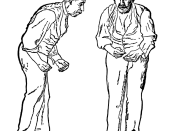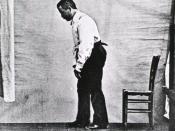Parkinson's Disease
Parkinson's disease was first discovered by a British physician named James Parkinson. He published a paper about the disease called "the shaking palsy". Around the early 1960s, researchers found a form of brain damage. This lead to the first treatment for the disease suggesting ways for more effective therapies and have introduce a new medication called "Levodopa". About 50,000 Americans are effected with this disease. Parkinson's disease strikes men and women in almost equal numbers but men are the common target. Studies show that African-Americans and Asians are less likely than whites to have Parkinson's disease.
Parkinson's disease belongs to a group of conditions called "motor system disorders" (movement of the body). Occurs when an area of the brain known as the "substantia nigra" is damaged, and can no longer make dopamine(, the neurotransmitter that carries movement orders to various parts of the body. Some of the symptoms are tremor or trembling in hands, arms, legs, jaw, face and postural instability or impaired balance and coordination.
Its also causes your movement to slow down and stiffens in limbs and trunks. The 4 major symptoms are "Tremor" which is the rhythmic back and forth motion of the hands and fingers, "Rigidity" or a resistance to movement, in which there is a stiffness of the muscles. "Bradykinesia" (Brady-slow, kinesis-movement) or the slowing down and loss of spontaneous and automatic movement, is particularly frustrating because it is unpredictable, and "Postural instability" or poor balance and coordination, causes patients to have a forward or backward lean and to fall easily. Parkinson's disease occurs over a long period and symptoms grow worst over time.
The numbers of Parkinson's patient are about 15-25%, having a relative with Parkinson's. There appears to be a 2-3 increased risk of Parkinson's in...



Parkinson's Diease
It could have been more juiced up. it needs more information about what it is all about. it hasn´t got references it seems to me that this essay was just submitted as a quick easy essay that was put together with no thought or effort.
1 out of 1 people found this comment useful.